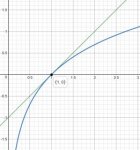Have you learned about the "difference quotient", a.k.a. the "slope formula"? This question is presumably leading your toward the definition of the "derivative", which is the limit of the difference quotient.
Consider the point (1,0) on the graph of ln(x), and any other point, (x, ln(x)). What is the slope of the line joining these points?
The expression you should have just written is exactly the expression you were asked to find the limit of! And the limit of the slope of such a line (called a secant line) is the slope of the tangent line. I would imagine this idea has been discussed in your textbook or class, in order for them to ask you this question.
To understand, take that graph you were shown, and put dots at (1,0) and some other point, such as (2, ln(2)). Draw the line through these points. Now pick another point on the graph closer to (1,0), and draw another line. Continue doing this, and you should see that the lines you draw get closer and closer to the tangent line. Therefore, the limit of these slopes will be 1, the slope of the tangent line.

